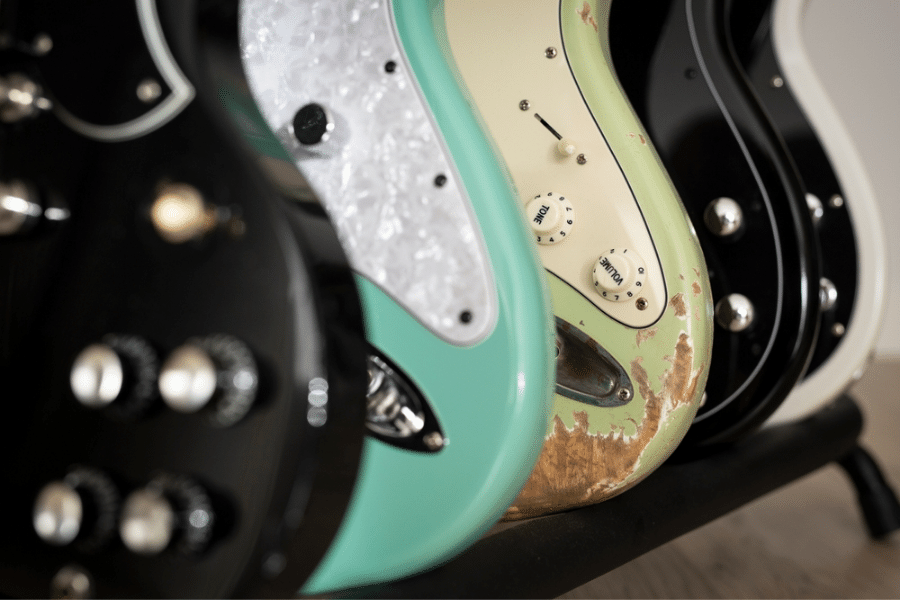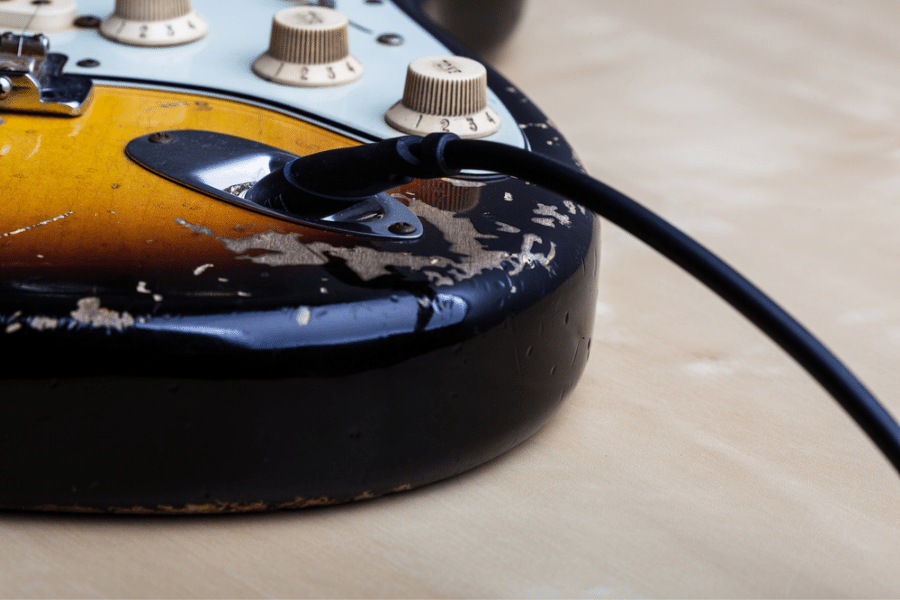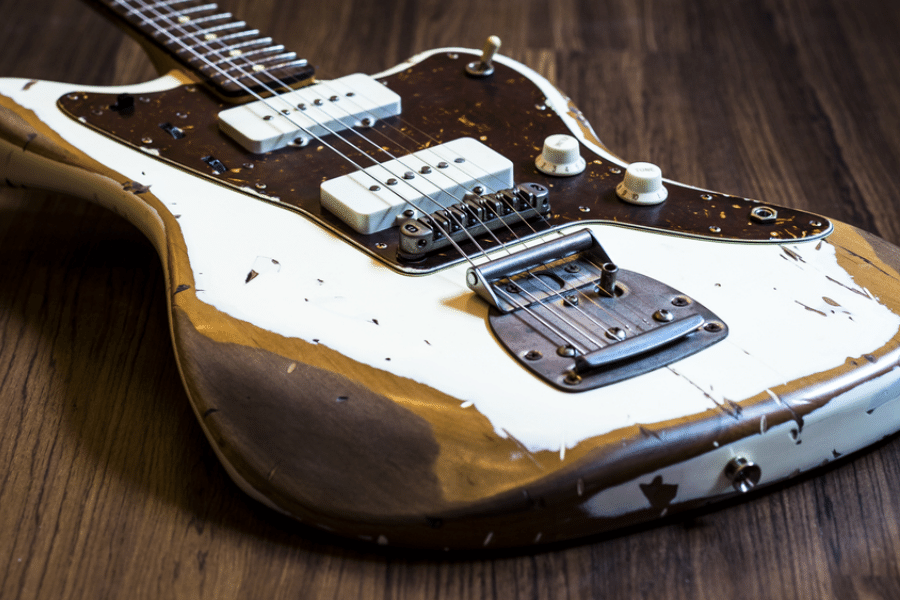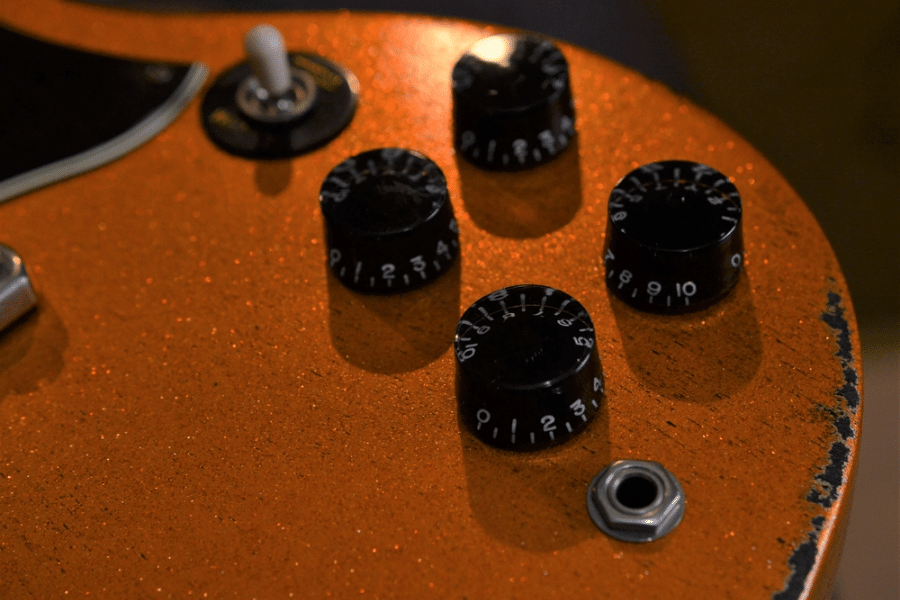Guitars that look old but are actually new? That is what relic guitars are.Some players think it’s cool that these guitars are made to look like they’ve been to a lot of shows and seen a lot of the world. People love these guitars because they look cool and feel like they’re holding a piece of rock history.
In this blog, Eguitarmania will show you all the cool stuff about these relic guitars. You’ll learn how people make them look old, why some guitar players really want them, and how they’re different from guitars that are actually old.

What Are Relic Guitars?
Have you ever been curious about a brand new guitar but looks like it’s already performed countless shows? They have scratches, dents, and faded paint, but all this is done on purpose.
Crafting a relic guitar that needs various techniques is like creating a masterpiece. They might physically distress the wood, apply layers of paint and then wear them down, or use special methods to crackle the varnish. It’s all about mimicking the wear and tear that happens over years of playing, they need both manual and chemical to create those marks.
- Chemical Treatments: To make the surface crack, fade, or turn yellow, special solutions can be used on it. This makes it look like it has been exposed to sunlight and time.
- Sanding and buffing: Targeted sanding gives the body’s edges and curves a worn look that looks like it has been used for years.
- Hand-Distressing: When luthiers want to give a guitar a really old look, they might add dings, scratches, and even buckle rash by hand using special tools.
- Heat Torching: Using heat carefully can make the finish check (get tiny cracks) and give it a more worn look.
What Makes Relic Guitars Special?
So, why would anyone want a guitar that looks beaten up? Let’s discover what makes these instruments outstanding:

The Look: Vintage Aesthetics
One of the most striking features of relic guitars is their appearance. These instruments often display a variety of wear marks, such as checking (fine cracks in the finish), dings, worn edges, and even rust on metal parts. This aesthetic aims to mimic the natural aging process that occurs with decades of use, creating an instrument that looks like it has a rich history of music-making.
The Sound: Vintage Tone Quest
While the visual and tactile aspects of relic guitars are immediately noticeable, there’s also a belief among some players that the relic’ing process can impact the instrument’s tone.
Though largely subjective, the theory suggests that, just as a genuine vintage guitar develops a richer, more resonant tone over time, a relic guitar might offer a similar sonic character right out of the gate.
The Feel: Played-In Comfort
Beyond their appearance, relic guitars are also known for their feel. The aging process often includes softening sharp edges on the neck and body, creating a more comfortable grip that feels like a well-worn pair of jeans. This “played-in” feel can make relic guitars more comfortable to play, especially for those who find brand-new instruments a bit stiff.
Not everyone is on board with the idea of relic guitars. Some purists believe that the only real way to get a vintage guitar is to buy an actual old guitar. They argue that artificially aging a guitar doesn’t give it the same soul or history.
On the other side, fans of relic guitars say that it’s a way to own a piece of history without the hefty price tag or the worries that come with playing a fragile, antique instrument.
Famous Musicians and Their Beloved Relic Guitars
The future of relic guitars is a fascinating one. Beyond their visual appeal, these guitars carry the weight of musical history. These guitars, with their worn finishes and signs of loving use, tell stories of creativity, performance, and musical evolution.

John Mayer and The Black1
John Mayer’s “The Black1” Stratocaster is a more contemporary example of a relic guitar, custom-built to Mayer’s specifications, including a thorough relic’ing process to achieve a vintage look and feel. Mayer has used “The Black1” extensively in the studio and on stage, showcasing how even modern musicians seek the unique character and mojo of relic guitars. The guitar’s worn finish and personalized touches speak to Mayer’s quest for a distinct sound and aesthetic, bridging past and present.
Eric Clapton and “Blackie”
Eric Clapton’s relationship with his Fender Stratocaster, affectionately known as “Blackie,” is another iconic example of a musician’s bond with a relic guitar. Assembled from the best parts of three vintage Stratocasters that Clapton purchased in the early 1970s, “Blackie” was his main stage guitar for much of the 1970s and 1980s.
The wear on its black finish and the natural relic’ing that occurred from Clapton’s extensive use made “Blackie” a visually and sonically distinctive instrument. Clapton’s choice of “Blackie” for countless performances and recordings underscores the deep connection musicians can have with their instruments.
Stevie Ray Vaughan and “Number One”
One cannot discuss relic guitars without mentioning Stevie Ray Vaughan and his beloved “Number One” Fender Stratocaster. This guitar, which became almost as legendary as Vaughan himself, bore the marks of countless gigs and tireless play.
With its sunburst finish worn away in many places, exposing the wood underneath, and a handle of duct tape used for quick repairs on the road, “Number One” wasn’t just an instrument; it was a testament to Vaughan’s passionate and vigorous playing style. The guitar’s distinct tone—a combination of Vaughan’s ferocious technique and the Strat’s weathered body—helped define the sound of modern blues.
Levels of Relic
Think about how much “wear” you want and what kind of music you want to play.
while it can’t replicate a guitar’s history, the Fender Custom Shop’s relic’ing process can get you that broken-in feel and look that will remind you of some of the most iconic guitars in the world.
N.O.S.
N.O.S., or New Old Stock, is a bit of the outsider here, as it’s as if the guitar is brand new… but bought in the 1950s or ’60s. The instrument is made to vintage specs, but without any wear, faded finish, tarnished hardware, or other signs of age. This level of relic is perfect for you if you want everything that is great about Fender guitars of yesteryear, but wants each scratch and ding to come from your own hands and experiences.
Closet Classic
We’ve all heard stories of to-die-for vintage guitars found in Grandma’s attic, hardly ever played. That’s the Closet Classic. It’ll be in great shape with very little wear, but it has aged to perfection with the passage of time. Maybe a few light scratches grace the finish, the plastic on the pickguard and pickups have begun taking on that unmistakable yellowish tint, and a minimal amount of tarnish is beginning to be visible on the hardware. The Closet Classic gives you the feeling of playing a long-lost treasure.

Journeyman Relic
Here’s where we get into the look and feel of a guitar that’s been loved and played. If you play your instrument often, it’s a simple truth that your axe will eventually show some wear. Even for players who take great care of their guitars, a fall from a stand, other people’s wandering hands, or even the mysteriously appearing ding can take a toll. Each of those marks adds character. And that’s what you get with Fender Custom Shop’s Journeyman Relic level. A well-taken-care-of instrument that has been played, gigged, and loved.
Relic
Take a guitar like the Journeyman Relic and put it on tour for 30 to 40 years. That’s Fender Custom Shop Relic level. Life happens, and that can definitely be said for this degree of relic’ing. The guitar will be gloriously dinged, scratched, dented, and possibly even burned a bit. One of the most attractive features of this level is the worn-in neck that Fender offers. You’ll feel raw wood under your hand, giving you the comfort of your favorite pair of broken-in sneakers. As soon as you wrap your hands around a Relic, you’ll feel like you’ve been playing it for years and years.
Heavy Relic
If you see nothing but beauty in SRV’s Number 1, Rory Gallagher’s Strat, or Jeff Beck’s Yardbirds-era Esquire, then Heavy Relic is right up your alley. The most extreme of all of Fender’s relic’ing levels, Heavy Relic invokes the spirit of the most time-tested, road-worn, and battle-hardened workhorse Fenders in history. “Broken-in” is a cliche used often for relic’d instruments. But there simply isn’t a better term for how these instruments look and feel. If you want an axe that looks like it hasn’t left your side since the beginning of rock ‘n’ roll, this is the relic job for you.
Final Thought
Even though your relic guitar looks old, it still needs love and care. Will relic guitars stand the test of time, or are they just a passing trend? Relic guitar is a unique niche in the guitar world, catering to players who appreciate the look and feel of a well-worn instrument.









